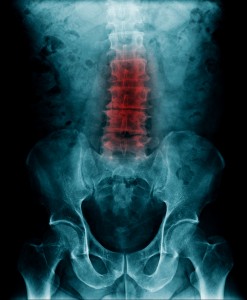Summary of Recent Publication, “Mesenchymal Stem Cell Levels of Human Spinal Tissues”
 Back pain caused by degenerative disc disease has been estimated to affect nearly 1 in 3 Americans and costs the United States roughly 50 to 100 billion dollars in lost work hours each year. Mesenchymal stem cells represent an exciting new development in the treatment of back pain. Dr. Vangsness and colleagues recently conducted a study of isolated mesenchymal stem cells to improve treatment for degenerative disc disease. Their findings suggest that human spinal tissue is a consistent and reliable source of these unique cells.
Back pain caused by degenerative disc disease has been estimated to affect nearly 1 in 3 Americans and costs the United States roughly 50 to 100 billion dollars in lost work hours each year. Mesenchymal stem cells represent an exciting new development in the treatment of back pain. Dr. Vangsness and colleagues recently conducted a study of isolated mesenchymal stem cells to improve treatment for degenerative disc disease. Their findings suggest that human spinal tissue is a consistent and reliable source of these unique cells.
Background
Current treatments for back pain are generally limited to analgesics, physical therapy, and surgery. While conservative measures such as analgesics and physical therapy can often improve back pain, surgical treatment for degenerative back pain is often ineffective. Consequently, new treatments to slow, prevent, and reverse degenerative spine disease are critical to improving the care and quality of life for back pain sufferers.
Mesenchymal stem cells have regenerative abilities that demonstrate a promising application in the treatment of degenerative conditions that have traditionally had poor prognoses. As the study of these cells has progressed, mesenchymal stem cells have been found and isolated from tissues throughout the body. Only recently, however, have mesenchymal stem cells been isolated from tissues within the spine itself, and prior to this study, their numbers within spinal tissues had yet to be examined. For these reasons, the authors of the study sought to compare the levels of mesenchymal stem cells isolated from human spine tissues to those from other tissues in the body.
The Study
The study was conducted as a review of the current literature available on the PubMed, MEDLINE, EMBASE, and Cochrane databases. The authors reviewed articles relating to the harvest, characterization, isolation, and quantification of human mesenchymal stem cells from spinal tissues. Selected articles were examined for relevant data, categorized according to the type of spinal tissue, and when possible, standardized to facilitate comparisons between sites.
Study Results
The results of the study showed that mesenchymal stem cells in various tissues of the spine were considerably higher than previously thought. Levels within the ligamentum flavum (a type of spinal tissue) were comparable to bone marrow, which is the traditional standard source for stem cell harvest. The study found that mesenchymal stem cells have been successfully isolated from five different tissues in all levels of the spine.
Conclusions
The results of the study present a favorable conclusion. Numerous tissues within and surrounding the spine represent a consistent and reliable source for the harvest and isolation of human mesenchymal stem cells. Among the tissues of the spine, the annulus fibrosus and ligamentum flavum each offer considerable levels of mesenchymal stem cells, which may prove comparable to that of bone marrow. In application, these mesenchymal stem cells show promise in improving effective treatments of back pain for individuals with degenerative disc disease.